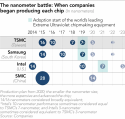Wooo, fancy. Nah, not really, that's just that kind of pablum a liberal arts major "journalist" would write. I could write you a story like that about any technology that China has already mastered. You are right that it would take decades of research for China to master it... good thing it's been researching it since at least 2000. You think China just woke up to this game? Not at all, it saw all this happening from miles away. By the way, that edifying discussion is about the light source, something which the Changchun Institute of Optics announced a breakthrough in before things went silent. Do you think they went silent because all the researchers suddenly decided to destroy their brains by huffing glue before dynamiting their lab and bringing progress to a halt, or do you think it went silent because it moved to a phase where it's a sensitive national security matter and people generally don't blab about things like that?
I think people need to understand and appreciate what China is because sometimes people can think it's a country. They say that it took Germany umpteen years to do this and Japan a bazillion to do that. China is not a country, it is a world. Even with its relative backwardness and poverty there is simply no basis for comparing the scale of talent and money China can hurl at a problem to anyone else.
Suppose Huawei handset and laptop division goes belly up, do you think that's going to stop the company? Do you understand that the Chinese state's backing and its capacity to marshal resources are essentially limitless? Do you think American technology companies won't be destroyed by severe Chinese retaliation? Can America support its companies the way China can?
Edit: On a technical note, why did China decide to go the discharge-produced plasma (DPP) route rather than the laser-produced plasma (LPP) route that ASML took? From what I can see in the literature, the LPP route has clear power-efficiency advantages.

